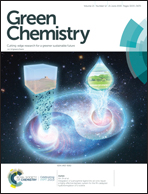Multi-tasking hydrated ionic liquids as sustainable media for the processing of waste human hair: a biorefinery approach†
Abstract
The abundance and unique characteristics of keratin containing natural protein fibres such as wool and silk suggest their use as an alternative to certain petroleum based polymers. Among keratin containing resources, human hair is one of the most abundant keratin rich natural fibres and is one of the most plentiful waste materials produced by human beings. It has been estimated that about 300 000 tons of hair are thrown away per annum in the world. Keratin can be produced from waste human hair (WHH) in a cost effective way and can be utilized in the preparation of biomaterials. Due to the excellent solvation properties of ionic liquids (ILs), the solubility of WHH was investigated in various hydrated ILs (HILs). Among the HILs, tetrabutylammonium hydroxide (TBAH, 40% aqueous solution) is found to completely solubilise 25% w/w of WHH. Melanin and keratin with 20–22% and 36–38% yield were isolated from the solution and due to the very good nitrogen content (6.99%) in the HIL remaining after the isolation (39–40%), it can be used to fortify nitrogen deficient liquid seaweed fertilizers for agriculture applications. The biorefinery concept presented herein is found to be suitable for up scaling.



 Please wait while we load your content...
Please wait while we load your content...